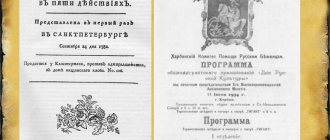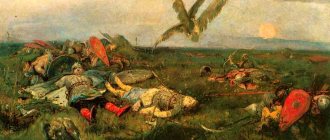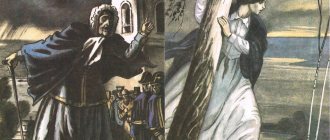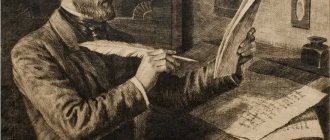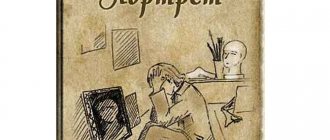“Scarlet Sails” by A. Green should be read by those who are true to their dreams and by those who believe that dreams do not come true and that dreaming is useless. The work captivates with its unusual images and magical plot. They study it in the 6th grade, but many readers return to it as adults to once again find themselves in the world of kindness and fairy tales. We offer an analysis of the work that will help during preparation for the lesson. The analysis presents the most important points of the literary analysis according to the plan.
History of creation
Alexander Green worked on the story for 4 years. The history of the creation of “Scarlet Sails” is shrouded in a flair of fairy-tale romance. One day the writer was walking around St. Petersburg. Suddenly, a store window appeared in front of him, on which there was a toy ship with white sails.
In 1916, specific prerequisites for creating a story were born in the writer’s fantasies. He gives preference to scarlet sails instead of the white ones he saw, identifying the chosen color with hope and happiness.
In the spring of 1922, the printed publication “Evening Telegraph” published one chapter from a work called “Gray”. And in 1923, Green’s immortal creation was published as a separate book.
Who wrote Scarlet Sails
The author of the work lived from 1880 to 1932. His full name is Grinevsky Alexander Stepanovich. The future writer became interested in the maritime theme after reading D. Swift’s work about Gulliver’s travels. After graduating from the Vyatka city school in 1896, Green settled in Odessa and began to dream of a career as a sailor. But he didn’t succeed right away; he had to wander and go hungry.
A friend of his father helped Green get a job as a sailor on a ship. But the sailor’s work turned out to be hard and did not bring any pleasure. In 1897, Alexander returned to Vyatka, and later left for Baku and worked there as a laborer and fisherman. Then, fate threw him to the Urals, where he had to be a lumberjack, a miner and a theater copyist.
In 1902, Green became an ordinary soldier, from where he deserted twice. In 1903, Green was arrested for criticizing the existing system. After his release, he goes to St. Petersburg, here he is again taken into custody and sent to Siberia, from where he flees, then moves to Moscow with someone else’s passport. Since 1906, Green has been working a lot, writing romantic stories - Captain Duke, Reno Island, etc.
The writer dedicated the work Scarlet Sails to his wife (Nina Nikolaevna), and it was published in 1923.
The essence
The reader meets the father of the main character. His name is Longren and no one in this village likes him. After all, the widowed man allowed his fellow villager Menners to drown, but for a reason. Now the man is raising an unusual girl named Assol alone.
The girl lives with dreams of a noble prince who will certainly sail for her on a ship with scarlet sails. The villagers consider her crazy, but she endures the ridicule of others in silence, remaining true to her dream.
In the end, Arthur Gray, a native of a wealthy famous family, makes the dream of the innocent sweet girl Assol come true (Here, additionally, read a brief retelling of the work “Scarlet Sails” for the reader’s diary).
Analysis of the story “Scarlet Sails” Green
The story “Scarlet Sails” became the opposite of the reality in which people, and even the author himself, lived.
The years of revolution and civil war were full of hardships and fear for life. At this time, the author developed in his work the theme of the unusual fate of a person who is able to change not only himself, but also the world around him, making it better.
A brief and complete analysis of the story will help you see the features of the author’s style and the artistic value of the work.
Years of writing
- 1916-1922, publication date - 1923.
The history of creation
- the book was written during the difficult years of the revolution and civil war, it reflected the desire to lead people to a peaceful, calm life full of goodness, happiness, justice and love.
Genre
- travel, extravaganza or story-extravaganza (“extravaganza” is a theatrical performance that combines text, music, and stage effects).
The direction
is neo-romanticism, the opposite of realism and naturalism.
The main idea
is that a person should live as his soul and heart tell him, and not as society dictates.
Topic
- If even the wildest dream is considered impossible, then it can be fulfilled.
Problem
- People who dare to live as their dreams and aspirations dictate are under pressure from society.
And sometimes they become outcasts. Composition
- the story consists of 7 chapters.
The exhibition
is a story about the captain and his daughter Assol. The plot is an episode where Aigle predicts that the girl will meet a prince who arrives on a ship with scarlet sails. The climax is the episodes in which Gray begins to fulfill Assol’s dream. Denouement - Gray takes Assol and her father away on the Secret.
clause 1. Topics and problems
1. The theme of fate and choice of life path
Problem:
heroes create their own destiny, although they have many obstacles. Gray should have lived like his parents, but gave up luxury and title. And Assol experienced monstrous pressure because of loyalty to her dream, but did not give up on it.
2. The theme of rejection of people who are incomprehensible to society
Problem:
The opinions of others can sometimes ruin a person’s life, but you still need to listen only to your heart.
3. Theme of moral values
Problem:
the moral and spiritual values of society may not coincide with the values of the hero, and then you will have to choose what to give up - society or your principles. Loughren and Assol cannot take root in the world of greed, profit, meanness and hypocrisy, and therefore they abandon it.
clause 2. Idea and pathos (ideological and emotional assessment)
The author conveys to readers the idea that the world is full of miracles, many of them can be done by people themselves - by showing kindness, mercy, and care. Green believes that people will be able to create a society in which there will be no injustice, evil, meanness, or humiliation of the human person.
A ship with scarlet prussians is a symbol of rejoicing, joy, and the victory of good over evil.
clause 3. Main characters (their place in the figurative system)
Longren
- a sailor, a fisherman, and then a craftsman.
He became a widower early and began to raise his daughter Assol alone. A gloomy, withdrawn, silent person. He became an outcast in society after he punished the person responsible for his wife’s death: he did not save him from the stormy sea. He made money by selling toys that he made himself. He loves his daughter and is ready to do anything to make her life easier. When communicating with Assol, his kindness and gentleness are visible. Assol
is Longren's daughter, the main character.
The reader sees her growing up from birth to about 17-20 years old. In early childhood, she receives a prediction from a fairy tale collector, which she believes in for many years, which is why she is considered crazy. He becomes an outcast because of his father, but patiently endures their forced loneliness together. Smart, kind, sensitive, well-read girl. She is beautiful with the kind of beauty that is not loved in her homeland, in Kaperna. She waits for the prince and becomes his wife. The heroine is “not like everyone else,” which immediately makes her similar to Gray. Arthur Gray
is the heir of a wealthy family who dreamed of becoming a captain and became one.
He preferred adventure and danger to a luxurious life. Seeing Assol by chance, he immediately understands that she is united with him by kinship of souls and dissimilarity from others, alienation from society. Having learned about the prediction given by Assol, he fulfills it by making scarlet sails for his ship “Secret”. He takes the girl and her father away from Kaperna, where Assol met only condemnation and insults. In fact, he saves a girl from an evil society that has not forgiven her for being different from them. Egle
is an old man, a collector of fairy tales and songs, who predicted Assol’s wonderful fate. A man who immediately saw a bright future in the baby’s face.
Analysis 2
Researchers attribute the extravaganza story “Scarlet Sails” to Green’s early works. The work was created in 1923 and dedicated to Nina, the writer’s wife. Extravaganza is a theatrical genre; it is a fabulous, unusual theatrical performance with fancy and lush scenery.
The entire work is permeated by the idea of a miracle, a dream come true. The heroes of the story believe in miracles and perform them themselves.
The life of Longren, his wife and little Assol contrasts sharply with the lives of other inhabitants of the town. Their family comfort, warmth and love are contrasted with greed and rudeness, drunkenness and cruelty. Longren is an unusually caring father: he devotes his life to raising Assol, trying to raise her to be kind, sincere, and to maintain her faith in miracles. Longren and Assol live in poverty, without friends, the little girl helps her father in his craft. A beautiful story about a ship with scarlet sails heard from the wizard Egle gave Assol faith in happiness, hope for the best, which she keeps in her soul for many years.
Assol is not portrayed by Green as a beauty, but her appearance is very poetic and attractive. In Kaperna they laugh at the girl, consider her almost crazy and call her “ship’s” Assol.
The image of a ship , the dream of travel, freedom - this is what brings together the images of such different people as Assol and Arthur Gray. Arthur is an aristocrat, seemingly obligated by birthright to become the owner of the hereditary castle and family estate. Everything was changed by the picture he saw in the castle library. The boy is captivated by the image of a courageous captain, ready to argue with the elements, fearless and noble. So the dream of the sea, perseverance in achieving the goal changed what was destined from birth. Arthur is endowed with a heightened sense of justice, the ability to sympathize with the pain of others, and faith in miracles. He had to go through many trials before he turned from an inexperienced youth who could hardly cope with the hard work on the ship into a strong and experienced captain who is respected and loved.
And again, a magical, unprecedented chance allows two such different people to meet. And a miracle happens. Assol’s dream and the fairy tale that Gray creates are so beautiful that this idea captivates many. The musicians of the hired orchestra and the sailors of the “Secret” are also imbued with the wonderful atmosphere and become involved in this extravaganza.
A miracle created in the name of love brings everyone together and makes them believe in a fairy tale. And this feeling of a dream come true, the possibility of a miracle, also bewitches the readers of the story.
Main meaning and idea
The main idea that the writer is trying to develop can be described in the words of the main character: “You have to create miracles with your own hands. If the human soul requires a miracle, it needs to be done.”
The writer is trying to encourage the reader to keep bright dreams, no matter what, and also to do miracles for the sake of other people, just like that, without counting on their own benefit.
But there is no need to sit and expect a miracle. In addition to the fact that you need to do it yourself, you need to develop yourself and take care of your own soul so that it does not become hardened and is alive. Only in this case will a person be able to open up to the world and its magic.
The main character was close to nature, was friendly towards animals and watched flowers. The sea, the meadows, and the forest responded to the girl, they created new storylines and fantasies. Arthur, having everything in life since infancy, but feeling the lifelessness of the place where he lived, runs away from it, goes in search of adventure to fulfill his old dream - to become a captain.
It seems that fate itself brought the heroes together, but if you analyze their images, it becomes clear that both main characters seemed to be preparing for the magic that would soon happen. For dreams to come true, it still requires certain actions from a person. This is the main idea of the work.
Composition
The analysis of “Scarlet Sails” should be continued by characterizing the composition. Formally, the work consists of seven chapters, each of which tells about an important event that helps to understand the essence of the main problem. Plot elements are arranged in the correct sequence.
The exposition of the story is an introduction to Assol’s father and the main character herself. The plot is a stranger’s prediction about a meeting with a prince. The development of events is a story about Assol’s dreams, Gray’s story. Climax - Gray listens to stories about the “crazy” Assol. Denouement - Gray takes Assol on his ship. Extra-plot elements – landscapes, portraits – play an important role.
The peculiarity of the composition is that each chapter of the work is relatively complete, pushing to certain conclusions.
Main characters
We wrote a separate article about the heroes of the work - The main characters of “Scarlet Sails”.
The genre of the work is an extravaganza story. The fact that this is a story is evidenced by the following features: several plot lines are revealed, the system of images is quite branched, and the volume is quite large. Signs of an extravaganza: magical events, unusual, somewhat fabulous images, victory of good over evil.
In A. Green's story "Scarlet Sails" there are signs of two directions - neo-romanticism (the main characters feel different from everyone else), symbolism (images-symbols play an important role in realizing the ideological sound). Genre originality, system of images and plot determined the nature of artistic means. Paths help bring the work closer to fairy tales.
“Scarlet Sails”: genre
Alexander Green wrote “Scarlet Sails” as an extravaganza story with elements of neo-romanticism and symbolism. It contains all the elements characteristic of a story. Namely:
Magical events happen to the main characters, but they themselves are idealized:
“The Fate of Man”: an essay based on the work
Elements of neorealism include the alienation of the heroes:
From the symbolism in the work, the images that fill the plot with ideological sound are barrels with ancient wine and prophecy, scarlet sails, a ring and others.
Topics and problems
The main theme of the work is miracle, dream, fate and nature. All the themes of the story are truly enchanting:
- Beautiful landscapes play an important role in the work, and plants become friends over time. Nature consoles the main character, and the sea gave Assol hope for change for the better.
- The whole story is permeated with dreams - these are the dreams of Gray and Assol.
- The young man independently chose his path in life; he consciously refused to be a rich man. Assol also tries to create her own destiny; she chooses life in dreams, rather than vegetating among empty, envious and embittered villagers.
- Egle promised the young heroine a miracle, Arthur performs it, making all Assol’s dreams come true.
The writer touched on many problems in his work: revenge, anger, condemnation of strangers, oppression of society. The problems of the story are not fairy-tale, but social.
So, throughout the entire story, the reader can see how bad the people live in the village:
- all the residents mocked young Assol because they liked to think that they were better than the girl;
- did not communicate with the lonely Longren;
- not a single person helped a sick mother with a newborn child for free.
Longren did not help Menners out of a sense of revenge, since the latter demanded love from his wife for money, and everyone immediately forgot what a deceiver the innkeeper was and how much the sailor loved his wife, and began to hate the widower.
“Scarlet Sails” analysis of Green’s work - theme, plan, genre, main idea of the story
“Scarlet Sails” by A. Green should be read by those who are true to their dreams and by those who believe that dreams do not come true and that dreaming is useless. The work captivates with its unusual images and magical plot. They study it in the 6th grade, but many readers return to it as adults to once again find themselves in the world of kindness and fairy tales. We offer an analysis of the work that will help during preparation for the lesson. The analysis presents the most important points of the literary analysis according to the plan.
Moral of the story
In addition to the idea of a miracle, the writer tried to encourage readers to be kind to other people and not judge them. Neither Assol nor Longren deserve the way they were treated by the local population. At the behest of their parents, the children offended the young heroine, even threw stones and called her “gallows.” No one thought that if they helped Mary for free, her life would depend on it.
After the death of the woman, everyone was surprised at the vindictiveness and gloominess of her husband, who was left with a small child. The moral of the work is simple: you need to be kinder to others, only in this case everyone will feel better.
Green describes different heroes. Some of them build their own lives, taking into account the opinions of strangers, for example, the local population of the village. Egle, entering the settlement, did not hear anything interesting, only deceit, vulgarity, callousness and other vices that are inherent in empty people. Therefore, the traveler immediately saw in Assol the liveliness in her soul. People like this girl choose their own path, they attract positive heroes, they feel something familiar in them.
Naturally, the author embellishes a lot in the story; he created a fairy tale for the reader with a good ending. But this work will not leave anyone indifferent, because it contains so much magic and goodness that the reader wants to believe that miracles are possible today... Green drew this conclusion from life, and the rest from his enchanting story.
Popular topics today
Alexander Sergeevich Pushkin was the author of many fairy tales, and “The Tale of Tsar Saltan...” is also his work. In this fairy tale, the heroes overcome all adversities and in the end receive a well-deserved reward.
The main character of the work is Ivan Severyanych Flyagin, presented by the writer in the image of a simple man.
Every person has his own goal in life, i.e. a problem that a person wants to solve throughout his life. Growing up, becoming a person, changing his priorities, any person often changes his life goal.




